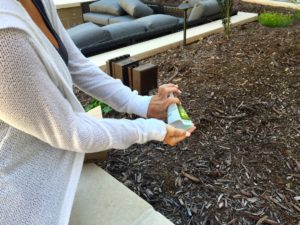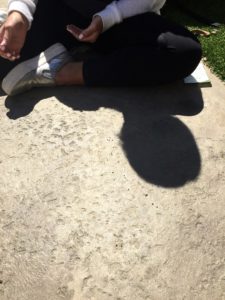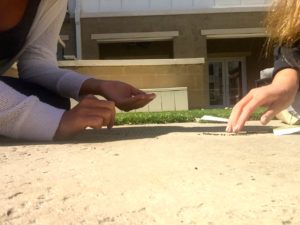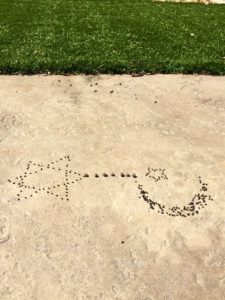Nikki Levy and Elyssa Rudnitsky
Seeds of Change
For this week’s prompt-based work, we decided to plant seeds in a political way. While watching the prompt, we both were immediately drawn to the political option, rather than the cultural or social alternatives. We felt it would have a more powerful impact, as people tend to have very polarizing and conflicting political opinions. Additionally, we opted to plant seeds, as we thought that this process- from burying the seeds, to deciding the location, to nurturing and watering the seeds, to watching them grow, has great potential for symbolic meaning and represents a long, complex progression. In other words, it takes a lot of work to get started planting the seeds, and even longer until the final product is revealed, which occurs when the seeds bloom into flowers. In order to plant in a political way, we arranged the seeds in the shape of political symbols. We chose to plant seeds in the shape of the Star of David, as well as the sign of Islam, as these are symbols with a history deeply rooted in conflict. By planting these symbols next to each other, we felt we could represent a future of change and peace, as there is time that has to pass before the flowers blossom and this relationship can improve.
On a personal note, we chose these symbols because we are both Jewish, and are very familiar with the tumultuous history between Palestinian Muslims and Israeli Jews. Last summer, we traveled to Israel for a 10-day trip in which we got to see various cities in Israel, such as Tel Aviv and Jerusalem, as well as listen and learn from our tour guides and local people about the importance of Judaism and the tensions that still exist in Israel today. This experience opened our eyes to the current state of Israel, as well as the significance of learning the history of our religion. Last semester, we then had the opportunity to travel to Morocco while studying abroad in Europe together. It was an extremely unique experience, as we were able to explore the local markets and mosques. In Morocco, Islam is the state religion, which made us feel anxious prior to our arrival. Despite these concerns, we personally did not experience any attacks or prejudice from Muslims due to our religion. Additionally, one of our close friends who is Moroccan and Muslim toured us through the country and explained her traditions and beliefs. This demonstrated that it is possible to put aside religious differences and get along based on other commonalities. These personal experiences led us to explore this political conflict upon hearing this prompt and we decided to represent this through planting the symbols of Judaism and Islam. This project enabled us to delve into the cultures that observe these religions and we saw that it is possible for religiously different people to co-exist.
We first went to Whole Foods and bought two types of flower seeds. While we initially wanted to plant the seeds in the grass, we soon realized that they wouldn’t be visible. Thus, as seen in the pictures, we put the seeds on the concrete, where they were then transferred to the greenery behind it. This was just the first roadblock of many that we encountered in this project; however, despite these obstacles, we felt it made the experience more politically charged, as there are many hurdles that need to be crossed before these two religions can work together. We also had to deal with wind, which would blow our seeds away and cause us to have to start over, just as many peace talks prove fruitless as soon as an act of violence further divides the region. We played around with placing the larger seeds in a circle around the symbols, or intertwining the two symbols; however, we decided to put a simple line to connect the two, to represent that these religions can and will remain on their own, but that it only takes a small step to find a common connection between them.
Overall, we felt this project was interesting and thought provoking, as it allowed for us to pick symbols that were personal and important to us, while also figuring out how something as simple as planting and gardening can have political meaning attached to it. Further, just as these seeds will have to be fostered and looked after as they slowly grow, the relationship between Jews and Muslims will also have to be worked on to improve and flourish over time. However, in the end when the flowers are in full bloom, what will appear is a striking image that at the very least, will cause people to stop, take a second look, and start a conversation about why and how these two symbols came to be planted connected to one another.





